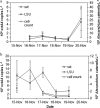sxtA-based quantitative molecular assay to identify saxitoxin-producing harmful algal blooms in marine waters
- PMID: 21841034
- PMCID: PMC3187097
- DOI: 10.1128/AEM.05308-11
sxtA-based quantitative molecular assay to identify saxitoxin-producing harmful algal blooms in marine waters
Abstract
The recent identification of genes involved in the production of the potent neurotoxin and keystone metabolite saxitoxin (STX) in marine eukaryotic phytoplankton has allowed us for the first time to develop molecular genetic methods to investigate the chemical ecology of harmful algal blooms in situ. We present a novel method for detecting and quantifying the potential for STX production in marine environmental samples. Our assay detects a domain of the gene sxtA that encodes a unique enzyme putatively involved in the sxt pathway in marine dinoflagellates, sxtA4. A product of the correct size was recovered from nine strains of four species of STX-producing Alexandrium and Gymnodinium catenatum and was not detected in the non-STX-producing Alexandrium species, other dinoflagellate cultures, or an environmental sample that did not contain known STX-producing species. However, sxtA4 was also detected in the non-STX-producing strain of Alexandrium tamarense, Tasmanian ribotype. We investigated the copy number of sxtA4 in three strains of Alexandrium catenella and found it to be relatively constant among strains. Using our novel method, we detected and quantified sxtA4 in three environmental blooms of Alexandrium catenella that led to STX uptake in oysters. We conclude that this method shows promise as an accurate, fast, and cost-effective means of quantifying the potential for STX production in marine samples and will be useful for biological oceanographic research and harmful algal bloom monitoring.
Figures



Similar articles
-
Gene expression and molecular evolution of sxtA4 in a saxitoxin producing dinoflagellate Alexandrium catenella.Toxicon. 2014 Dec 15;92:102-12. doi: 10.1016/j.toxicon.2014.09.015. Epub 2014 Oct 7. Toxicon. 2014. PMID: 25301480
-
Gene duplication, loss and selection in the evolution of saxitoxin biosynthesis in alveolates.Mol Phylogenet Evol. 2015 Nov;92:165-80. doi: 10.1016/j.ympev.2015.06.017. Epub 2015 Jun 30. Mol Phylogenet Evol. 2015. PMID: 26140862
-
High Specificity of a Quantitative PCR Assay Targeting a Saxitoxin Gene for Monitoring Toxic Algae Associated with Paralytic Shellfish Toxins in the Yellow Sea.Appl Environ Microbiol. 2015 Oct;81(20):6973-81. doi: 10.1128/AEM.00417-15. Epub 2015 Jul 31. Appl Environ Microbiol. 2015. PMID: 26231652 Free PMC article.
-
Environmental Factors Modulate Saxitoxins (STXs) Production in Toxic Dinoflagellate Alexandrium: An Updated Review of STXs and Synthesis Gene Aspects.Toxins (Basel). 2024 Apr 30;16(5):210. doi: 10.3390/toxins16050210. Toxins (Basel). 2024. PMID: 38787062 Free PMC article. Review.
-
Bioluminescence and toxicity as driving factors in harmful algal blooms: Ecological functions and genetic variability.Harmful Algae. 2020 Sep;98:101850. doi: 10.1016/j.hal.2020.101850. Epub 2020 Jul 29. Harmful Algae. 2020. PMID: 33129462 Review.
Cited by
-
The Genetic Basis of Toxin Biosynthesis in Dinoflagellates.Microorganisms. 2019 Jul 29;7(8):222. doi: 10.3390/microorganisms7080222. Microorganisms. 2019. PMID: 31362398 Free PMC article. Review.
-
Development of a Method for Detecting Alexandrium pacificum Based on the Quantification of sxtA4 by Chip-Based Digital PCR.Toxins (Basel). 2022 Feb 2;14(2):111. doi: 10.3390/toxins14020111. Toxins (Basel). 2022. PMID: 35202138 Free PMC article.
-
Genomic copy number variability at the genus, species and population levels impacts in situ ecological analyses of dinoflagellates and harmful algal blooms.ISME Commun. 2023 Jul 8;3(1):70. doi: 10.1038/s43705-023-00274-0. ISME Commun. 2023. PMID: 37422553 Free PMC article.
-
qPCR Assays for the Detection and Quantification of Multiple Paralytic Shellfish Toxin-Producing Species of Alexandrium.Front Microbiol. 2018 Dec 18;9:3153. doi: 10.3389/fmicb.2018.03153. eCollection 2018. Front Microbiol. 2018. PMID: 30619217 Free PMC article.
-
Evaluation of sxtA and rDNA qPCR assays through monitoring of an inshore bloom of Alexandrium catenella Group 1.Sci Rep. 2019 Oct 10;9(1):14532. doi: 10.1038/s41598-019-51074-3. Sci Rep. 2019. PMID: 31601884 Free PMC article.
References
-
- Ajani P., Hallegraeff G., Pritchard T. 2001. Historic overview of algal blooms in marine and estuarine waters of New South Wales, Australia. Proc. Linneus Soc. N. S. W. 123:1–22
-
- Allen A. E., Ward B. B., Song B. 2005. Characterization of diatom (Bacillariophyceae) nitrate reductase genes and their detection in marine phytoplankton communities. J. Phycol. 41:95–104
-
- Anderson D. M., et al. 2005. Identification and enumeration of Alexandrium spp. from the Gulf of Maine using molecular probes. Deep Sea Res. II Top. Stud. Oceanogr. 52:2467–2490
-
- Bajarias F. F., Relox T., Jr, Fukuyo Y. 2006. PSP in the Philippines: three decades of monitoring a disaster. Coast. Mar. Sci. 30:104–106
Publication types
MeSH terms
Substances
LinkOut - more resources
Full Text Sources
Other Literature Sources

